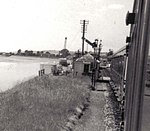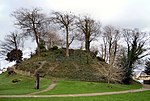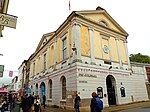Barnstaple Town F.C.
1904 establishments in EnglandAssociation football clubs established in 1904Barnstaple Town F.C.Devon and Exeter Football LeagueEngvarB from February 2014 ... and 6 more
Football clubs in DevonFootball clubs in EnglandNorth Devon Football LeagueSouthern Football League clubsSport in BarnstapleWestern Football League
Barnstaple Town Football Club is a football club based in Barnstaple, Devon, England. They are currently members of the Western League Premier Division and play at Mill Road.
Excerpt from the Wikipedia article Barnstaple Town F.C. (License: CC BY-SA 3.0, Authors).Barnstaple Town F.C.
Pottington Road, North Devon Pilton
Geographical coordinates (GPS) Address Nearby Places Show on map
Geographical coordinates (GPS)
| Latitude | Longitude |
|---|---|
| N 51.082561944444 ° | E -4.0685961111111 ° |
Address
Barnstaple Town Football Club
Pottington Road
EX31 1JH North Devon, Pilton
England, United Kingdom
Open on Google Maps








